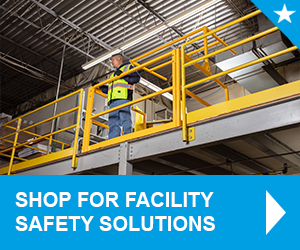
Industrial facilities, manufacturing plants, and warehouses are full of potential hazards that may injure workers. No matter what industry you operate in, how big your buildings are, or how many employees you have, it’s your obligation to provide your employees with a safe workplace. That means identifying and eliminating as many risks as possible while mitigating those that cannot be completely removed, like most fall hazards. To minimize the risks of working at heights, you must provide workers with OSHA-compliant fall protection equipment such as modular guardrail systems.
Does OSHA Require Guardrails for Fall Protection?
Although OSHA 1910.28 requires employers to provide fall protection whenever employees work at heights of 4′ or more, there is no requirement for guardrails. In fact, OSHA leaves it up to the employer to determine whether it is best to use modular guardrails or another type of fall protection equipment in a given situation.
What Are Modular Guardrail Systems?
A modular guardrail system provides the same fall protection as a static guardrail setup. It’s basically a railing that is placed around a fall hazard with the intention of protecting people from falling. The major difference between the two is the fact that a modular guardrail can be configured to fit any area. Generally speaking, a standard guardrail is less flexible and can be more difficult to configure.
Are Modular Guardrails OSHA-Compliant?
Modular guardrail systems are required to meet the same standards as any other guardrail per OSHA 1910.29. Namely, they must be 42″ tall (measured from the walking surface to the top rail), able to withstand 200 lbs. of force on top rails and 150 lbs. on mid rails without failing and be made of smooth material that won’t scratch skin or snag clothing.
Are Modular Guard Rails a Temporary Solution?
They can be, but they’re not limited to temporary use. On one hand, modular safety rails can be used as a short-term fall protection solution. They’re a great way to provide protection around elevated surfaces, holes, and other fall hazards. For example, modular railings can be used to protect an opening in a wall during repairs. However, a properly installed modular guardrail system may also be used as permanent fall protection inside your facility.
Where Can I Use a Modular Guardrail System?
Perhaps a better question would be; where can’t you use a modular guardrail system? The truth is that a modular guardrail is the ideal indoor fall protection solution for a wide variety of applications. Use them on elevated walkways and mezzanines, to protect stairways and ladder entrances, on uneven surfaces, around restricted areas, and anywhere else there’s a fall hazard.
Are Modular Guardrails Good for Machine Guarding?
Absolutely. In fact, we highly recommend modular rails for machine guarding. Because they can be arranged in endless shapes and sizes, modular guardrails are an ideal solution to keeping machines and employees safe. Remember that, regardless of the height, whenever employees work above dangerous machinery, you need machine guarding and fall protection devices in place to protect them.
Is It Difficult to Move and Reconfigure Modular Safety Rails?
One of the major benefits of using a modular safety railing system is the fact that they’re easy to move to another spot, or to disassemble and put into storage for future use. In just a few moments, one or two individuals can break down a set of modular guard rails, move them to another location, and set them up again in a new shape. It’s easy, and you don’t need a box full of tools.
Are Modular Railings Durable?
A modular safety railing system can be just as long-lasting as any permanent railing system. Remember that any modular guardrail system should be constructed of strong, durable materials that can withstand a certain amount of abuse without failing. Not only will this ensure the safety of employees, but it will also keep your company in compliance with OSHA regulations, thus avoiding fines and penalties.
Are Modular Guardrails Easy to Install?
Unlike some other forms of fall protection, installing modular railings is a pretty simple process. In fact, it doesn’t take long, and you won’t need an engineering degree to get the job done correctly. Even so, it’s always a good idea to install OSHA-compliant fall protection under the direct supervision of a qualified safety expert. That way, you can rest easy knowing everything is installed per OSHA regulations.
Should I Use a Safety Gate with a Modular Guardrail?
Keep in mind that a modular guardrail system provides adequate indoor fall protection if it meets the OSHA standard noted above. You could configure a railing so that there is an offset that doesn’t lead directly to an opening or hole that presents a fall hazard. However, a self-closing industrial swing gate may also be added to your guardrail system at one or more entrance points and around openings to enhance fall protection and ensure OSHA compliance.
Where Can I Get OSHA-Compliant Modular Rails?
When it comes time to upgrade your indoor fall protection equipment, rely on the safety experts at Tractel. We offer a complete line of OSHA-compliant fall protection designed to protect employees working at height. Our guardrails meet or exceed all OSHA requirements for strength and durability, and our safety gates are 100% OSHA-compliant and compatible with all of our safety railing systems.
Contact FABENCO for a Fall Safety Equipment Consultation
Questions? Contact the fall protection experts at Fabenco today to discuss your indoor fall protection needs with one of our highly qualified staff. We will happily help you decide whether a traditional guardrail or modular guardrail systems are right for your facility. We can also offer expert advice regarding any other fall protection equipment questions you may have. Our goal is to make your workplace as safe as possible for you and your employees.





